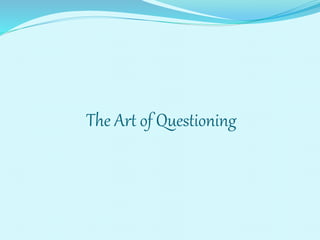
The Art of Questioning
- 1. The Art of Questioning
- 2. One of the teaching tools conveniently placed in the hands of the teacher is the question. And yet, too many teachers either use it carelessly or fail to see its possibilities for promoting effective learning. Even with the teaching formula of “Assign, Study, Recite, Test” of the traditional school. The ability to ask questions was a necessary art. The fact, the traditional classroom at all levels was dominated by activities of the question- and-answer type.
- 3. Categories of Questions Knowledge (who, what, whom, where, why, how) Comprehension (retell) Analysis (What are the parts of.... ? features of....? Classify according to....) Application (How is.... an example of....? How is.... related to.....? Why is.... significant....?) Synthesis (What would infer from? What ideas can you add to? How would you design a new....? What would happen if you combine...?) Evaluation (Do you agree that...? What do you think about...? What is the most important.....? Place the ff. in order of priority. How would you decide about...? What criteria do you need to use to assess....?)
- 4. Uses of Questions To stimulate pupils to think To motivate pupils To diagnose pupil’s difficulties To discover pupil’s interest To help pupils organize and evaluate To aid pupils to relate pertinent experiences to the lesson To focus pupil’s attention To develop new appreciation and attitudes To provide drill or practice To show relationships such as cause and effect To encourage the application of concept
- 5. Types of Questions According to Purpose For assessing cognition For verification For creative thinking For evaluating For productive thinking For motivating For instructing
- 6. Types of Questions According to Level Low level High level Convergent Divergent
- 7. Characteristics of Good Questions brief, clear, and unequivocal not be lifted from the book suited to the age, experience, and ability of the student deal with only one idea vary in difficulty applicable to all students thought-provoking and challenging are not self-answering relevant to the lesson under discussion in good grammatical form
- 8. Questioning Skills and Conduct of Good Questioning Varying type of questions Ask questions in conversational tone Asking non-directed questions Calling on non-volunteers Students should not be called in fixed order Allowing for sufficient wait time Courtesy between the teacher and his students should prevail during the questioning session
- 9. Handling Student’s Response Show appreciation for any answer Wrong answers should never be allowed to go uncorrected Giving appropriate praise for high quality responses Following up a student’s response with related questions Answering in chorus should not be allowed by the teacher Student should recite to the whole class, not to the teacher Students should be encouraged to observe correct grammar and answer in complete sentence Showing non-verbal encouragement Refrain from marking the student in the record book during class recitation
- 10. Handling Student’s Questions Teacher should be glad to welcome questions Irrelevant and inane questions should not be entertained Questions should be thrown first to the whole class for an answer or discussion Questions should be in correct grammar or in good language The teacher should honestly admit if he does not know the answer to a question Very shy students should be encouraged to write their questions anonymously and give them to the teacher Allot appropriate time slot for open questioning
- 11. Sequence of Questions Easy Normal Typical Common Ordinary Difficult
